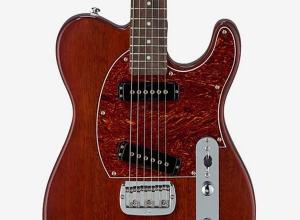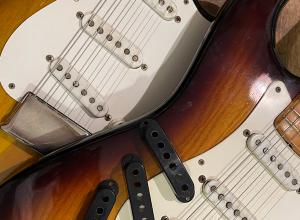È il 1972 quando il sedicenne Paul Reed Smith concepisce per la prima volta l’idea di possedere una chitarra con intarsiato un drago sulla tastiera, ma dovrà attendere ben vent’anni per trasformare quel sogno in realtà. Infatti nel 1992 la fabbrica di strumenti a marchio “Paul Reed Smith” è già una realtà consolidata ed apprezzata sul mercato per il livello qualitativo dei suoi prodotti, e, grazie all’avvento della tecnologia laser, prende vita il progetto della “Dragon 1”.
Si tratta di una chitarra con 22 tasti e top in acero figurato, la cui tastiera riporta il disegno di un drago costruito con 201 preziosi intarsi di madreperla, intagliati a laser con precisione chirurgica. Costruita in 50 esemplari e venduta all’epoca a 8.000 dollari diventa istantaneamente un pezzo da collezione. L’unicità di questa chitarra, oltre al magnifico disegno sulla tastiera, sta anche nel fatto che per la prima volta viene utilizzato il ponte “stoptail” e una tastiera a 22 tasti per una PRS, mentre i pickup sono i nuovi “Dragon”, appositamente progettati per l’occasione.
Il disegno del drago lo ideò Jude Van Dike e lo sviluppo venne commissionato alla Pearl Works, società specializzata in questo tipo di lavorazioni. Dalla nascita della PRS sono trascorsi 37 anni e nel frattempo sono stati prodotti 9 diversi modelli di Dragon, ed oggi qui a Vintage Vault abbiamo il privilegio di presentarvi ben tre esemplari, che potete ammirare nella gallery fotografica in questa pagina.
Considerato il successo della Dragon I, Paul Reed Smith decide l’anno successivo di produrre un nuovo modello, la Dragon II. Lo sviluppo del nuovo disegno questa volta fu di Dave Hazel e la realizzazione venne affidata nuovamente alla Pearl Works. Questa volta gli esemplari costruiti furono 100 in totale (le foto ritraggono la chitarra nr.22). Le specifiche tecniche sono le seguenti:
- manico in mogano con profilo “wide-fat” e tastiera 22 tasti in palissandro brasiliano;
- firma di Paul Reed Smith sulla paletta in oro;
- corpo in mogano massiccio con top in acero figurato;
- prodotta nei seguenti colori: Amber, Dark Cherry, Sunburst, Indigo e Teal black;
- pickup 2 humbucker Dragon Treble&Bass;
- manopole del volume, tono e del selettore a 5 switch dei pickup;
- ponte modello stoptail.
Il modello successivo è una Dragon 2002, come è facile intuire l’anno di produzione è quello che da il nome alla chitarra. Anche questa volta le novità non si limitano solo al disegno del drago, che sarebbe già più che sufficiente, ma anche al modello. Per la prima volta infatti è stato utilizzato un modello single cut (che in seguito sarà motivo di un’azione legale avviata, e persa, dalla Gibson).
Oltre il 90% del top è impreziosito dal disegno in 3D del volto del drago, i cui preziosi materiali rendono la chitarra il modello in assoluto più pesante della produzione PRS. Lo strumento è stato prodotto in 100 pezzi, quello fotografato è il nr.73. Le specifiche della chitarra sono:
- manico in mogano brasiliano con profilo “wide-fat”, tastiera in 22 tasti in palissandro indiano;
- corpo in mogano massiccio, con top in acero figurato;
- prodotta in 3 colori: whale blue, black cherry, grey black;
- pickup 2 humbucker modello #7’s, coperti;
- manopole con 2 volumi, 2 toni e classico selettore swicth a 3 vie;
- ponte modello stoptail.
Il 35mo anniversario della PRS, nel 2020, è stata l’occasione per ideare il più recente dei modelli Dragon, denominato 35th anniversary Dragon, ed è stato prodotto in 135 copie. Il disegno del drago è un’idea di Jeff Easley & Aulson Inlay.
Le foto presenti nell’articolo non sono relative a nessuna delle chitarre prodotte in quanto si tratta del prototipo utilizzato per lo sviluppo della chitarra che è un ibrido, il corpo è quello della PRS McCarty ed i pickup sono della Paul’s Guitar. La chitarra, trattandosi di un prototipo ha solo la firma di Paul Reed Smith sul retro della paletta, come per tutte le chitarre Private Stock, successivamente è stata nuovamente firmata nuovamente da Paul sulla placchetta posteriore in plastica durante un suo recente viaggio in Italia. Le caratteristiche sono:
- manico in Chaltecocco con tastiera a 22 tasti in Ziricote e sulla paletta logo del Private stock;
- corpo in mogano massiccio africano con top in acero figurato;
- unico colore di produzione: Frostbite Dragon’s Breath;
- pickup TCI treble and bass;
- manopole volume, tono con push-pull per splittare da humbucker a single coil, selettore switch a 3 vie;
- ponte modello stoptail cromato in colore fumè.
Le chitarre, oltre ad essere strumenti di una qualità costruttiva fuori dal comune, coniugano una suonabilità eccezionale ad un look assolutamente unico. Sono vere e proprie opere d’arte, che, a nostro avviso, rappresentano perfettamente quei concetti di esclusività, eccellenza costruttiva, unicità, che incarnano il significato stesso del termine “Vintage”, ed a tutti gli effetti, questo tipo di PRS, assieme probabilmente anche alle prime cosiddette “pre factory”, rappresentano l’apice della produzione di Paul Reed Smith. Non mancate il prossimo 14 maggio a Vintage Vault per poterle ammirare dal vivo.
[EN] Into the Dragon’s eyes: the vision of Paul Reed Smith
Here at Vintage Vault we share the philosophy that considers “Vintage” the excellence, or the golden age of a particular manufacturer, in line with the oldest meaning of the term. In this regard, today we delve into the history of one of Paul Reed Smith’s most iconic models, the Dragon, with what can be considered “Vintage of tomorrow”.
It was 1972 when sixteen-year-old Paul Reed Smith first conceived the idea of owning a guitar with a dragon inlaid on the fretboard, but he had to wait twenty years to turn that dream into reality.In fact, by 1992 the “Paul Reed Smith” brand instrument factory was already a consolidated and appreciated reality on the market for the quality level of its products, and, thanks to the advent of laser technology, the “Dragon 1” project finally came to life .It’s a guitar with 22 frets and a figured maple top, whose fretboard bears the design of a dragon built with 201 precious mother-of-pearl inlays, laser-carved with surgical precision. Built in 50 units and sold at the time for 8,000 US dollars, it instantly became a collector’s item.
The uniqueness of this guitar, in addition to the magnificent design on the fretboard, also lies in the fact that for the first time the “stoptail” bridge and a 22-fret fretboard are used for a PRS, while the pickups are the new “Dragon”, specially designed for the occasion. The design of the dragon was conceived by Jude Van Dike and the development was commissioned to Pearl Works, a company specialized in this type of work.37 years have passed since the birth of PRS and in the meantime 9 different Dragon models have been produced, and today here at Vintage Vault we have the privilege of presenting you three specimens, which you can admire in the photo gallery below.
Given the success of the Dragon I, Paul Reed Smith decided the following year to produce a new model, the Dragon II. The development of the new design this time was by Dave Hazel and the construction was entrusted again to Pearl Works. This time the examples built were 100 in total (the photos show guitar no. 22). The technical specifications are as follows:
- mahogany neck with “wide-fat” profile and 22-fret Brazilian rosewood fingerboard;
- signature of Paul Reed Smith on the headstock in gold;
- solid mahogany body with figured maple top;
- produced in the following colours: Amber, Dark Cherry, Sunburst, Indigo and Teal black;
- pickups 2 Dragon Treble&Bass humbuckers;
- volume, tone and 5-switch pickup selector knobs;
- stoptail model bridge.
The next model is a Dragon 2002, as it is easy to guess the year of production is the one that gives the guitar its name. Also this time the news is not limited only to the design of the dragon, which would already be more than enough, but also to the model. In fact, for the first time a single cut model was used (which will later be the reason for a lawsuit initiated, and lost, by Gibson). Over 90% of the top is embellished with the 3D drawing of the dragon’s face, whose precious materials make the guitar the heaviest model ever produced by PRS. The instrument was produced in 100 pieces, the one photographed is number 73. The guitar specs are:
- Brazilian Rosewood neck with “wide-fat” profile, 22 Indian rosewood fretboard;
- solid mahogany body, with figured maple top;
- available in 3 colours: whale blue, black cherry, grey black;
- pickups 2 humbucker model #7’s, covered;
- knobs with 2 volumes, 2 tones and classic 3-way switch selector;
- stoptail model bridge.
The 35th anniversary of PRS, in 2020, was the occasion to design the most recent of the Dragon models, called the 35th anniversary Dragon, and it was produced in 135 copies. The dragon design is an idea by Jeff Easley & Aulson Inlay. The photos in the article are not related to any of the guitars produced as they are the prototype used for the development of the guitar which is a hybrid, the body is that of the PRS McCarty and the pickups are from Paul’s Guitar. The guitar, being a prototype, only has Paul Reed Smith’s signature on the back of the headstock, as with all Private Stock guitars, it was subsequently re-signed by Paul on the plastic back plate during his recent trip to Italy. The features are:
- chaltecocco neck with 22-fret Ziricote fretboard and Private stock logo on the headstock;
- solid African mahogany body with figured maple top;
- only production color: Frostbite Dragon’s Breath;
- TCI treble and bass pickups;
- volume knobs, tone with push-pull to split from humbucker to single coil, 3-way selector switch;
- smoked chrome stoptail model bridge.
The guitars, in addition to being instruments of an out of the ordinary build quality, combine exceptional playability with an absolutely unique look. They are real works of art, which, in our opinion, perfectly represent those concepts of exclusivity, manufacturing excellence, uniqueness, which embody the very meaning of the term “Vintage”, and to all intents and purposes, this type of PRS, together probably even at the first so-called “pre factory”, they represent the peak of Paul Reed Smith’s production. Don’t miss the Vintage Vault Guitar Show next May 14th to be able to admire them live. |
 VINTAGE VAULT
VINTAGE VAULT
 SHG MUSIC SHOW
SHG MUSIC SHOW
 PEOPLE
PEOPLE
 STORE
STORE
 - Privacy - Accordo.it Srl - P.IVA 04265970964
- Privacy - Accordo.it Srl - P.IVA 04265970964
![Nell’occhio del Drago: la visione di Paul Reed Smith [IT-EN] Nell’occhio del Drago: la visione di Paul Reed Smith [IT-EN]](https://www.accordo.it/cloud-assets/730x450/redazionea5/images/deco/105257_prs-g.jpg)















































